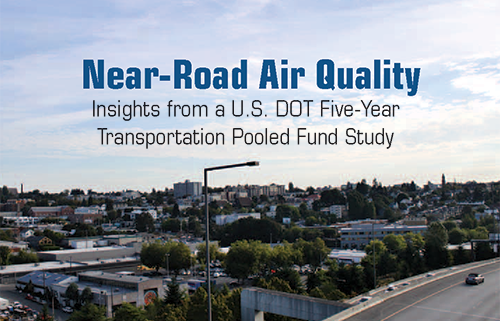TR News Article: Near-Road Air Quality - Insights from U.S. DOT Transportation Pooled Fund Study
Clients
Transportation Pooled Fund (TPF), which includes the U.S. Federal Highway Administration (FHWA) and the Arizona, California, Colorado, Ohio, Texas, Virginia, and Washington State Departments of Transportation (DOTs)
Air pollution from cars, trucks, and other vehicles can create pollution hot spots within a few hundred meters of major roadways. Near-road pollution is a health concern in environmental justice communities since they are disproportionately located near major roadways. To address these issues, eight state and federal transportation agencies formed a Near-Road Air Quality TPF five-year research program. The Washington State DOT served as the lead agency for the TPF, and Sonoma Technology provided planning and research support for all five years of the program. <br>
A <a href="https://onlinepubs.trb.org/onlinepubs/trnews/trnews332.pdf">summary of the TPF’s major findings</a> was published by the U.S. Transportation Research Board’s <i>TR News Magazine</i>. <a href="http://www.trb.org/Publications/Blurbs/182193.aspx" target="_blank"><i>TR News Magazine</i></a href> is copyright by the National Academy of Sciences, Engineering, and Medicine; posted with permission of the Transportation Research Board.<br>
The abstract of the article is below.<br>
Pollutants directly emitted by vehicles—from exhaust, wear from brake pads and tires, or dust from disturbing the road surface—are of special concern in areas adjacent to heavily traveled roads. Examples of pollutants of concern are the soot emitted from diesel vehicle exhaust, often referred to as diesel particulate matter (PM), oxides of nitrogen (NO and NO<sub>2</sub>), and toxics such as benzene. Near-road air quality is of particular concern given the growing awareness of the need to address environmental justice issues. Communities near heavily traveled roads are often more economically disadvantaged and have a higher proportion of minority residents than communities in other settings.<br>
In recognition of the importance of addressing near-road air pollution, the TPF’s eight state and federal agencies pooled their research efforts on the topic. With Sonoma Technology’s support, the TPF obtained and evaluated an unprecedented amount of near-road air quality data from U.S. Environmental Protection Agency (EPA)-mandated near-road air quality measurement sites located next to major highways across the United States.<br>
Sonoma Technology researchers completed national-scale assessments, case studies of various metropolitan areas, comparisons of modeled and measured air quality, mitigation assessments, and other work documented in six peer-reviewed journal articles and numerous reports and conference presentations. <a href="http://www.trb.org/Publications/Blurbs/182193.aspx" target="_blank">The March-April 2021 edition of <i>TR News</i></a href> featured a digest of the TPF’s overall work effort and findings.<br>
A <a href="https://onlinepubs.trb.org/onlinepubs/trnews/trnews332.pdf">summary of the TPF’s major findings</a> was published by the U.S. Transportation Research Board’s <i>TR News Magazine</i>. <a href="http://www.trb.org/Publications/Blurbs/182193.aspx" target="_blank"><i>TR News Magazine</i></a href> is copyright by the National Academy of Sciences, Engineering, and Medicine; posted with permission of the Transportation Research Board.<br>
The abstract of the article is below.<br>
Pollutants directly emitted by vehicles—from exhaust, wear from brake pads and tires, or dust from disturbing the road surface—are of special concern in areas adjacent to heavily traveled roads. Examples of pollutants of concern are the soot emitted from diesel vehicle exhaust, often referred to as diesel particulate matter (PM), oxides of nitrogen (NO and NO<sub>2</sub>), and toxics such as benzene. Near-road air quality is of particular concern given the growing awareness of the need to address environmental justice issues. Communities near heavily traveled roads are often more economically disadvantaged and have a higher proportion of minority residents than communities in other settings.<br>
In recognition of the importance of addressing near-road air pollution, the TPF’s eight state and federal agencies pooled their research efforts on the topic. With Sonoma Technology’s support, the TPF obtained and evaluated an unprecedented amount of near-road air quality data from U.S. Environmental Protection Agency (EPA)-mandated near-road air quality measurement sites located next to major highways across the United States.<br>
Sonoma Technology researchers completed national-scale assessments, case studies of various metropolitan areas, comparisons of modeled and measured air quality, mitigation assessments, and other work documented in six peer-reviewed journal articles and numerous reports and conference presentations. <a href="http://www.trb.org/Publications/Blurbs/182193.aspx" target="_blank">The March-April 2021 edition of <i>TR News</i></a href> featured a digest of the TPF’s overall work effort and findings.<br>
Related Links:
Air Quality
Emissions
Environmental Justice
Measurements
Modeling
Transportation


Douglas S. Eisinger

Douglas
S.
Eisinger
Senior Vice President / Chief Scientist, Transportation Policy & Planning
Doug@sonomatech.com
/sites/default/files/2023-02/DSEres.pdf
